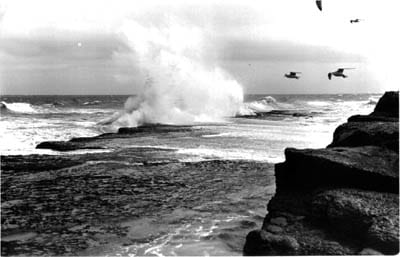
Photograph by Raymond Seed
In the study of community structure, larval recruitment, and physiology, rocky shores have proven to be the most versatile of habitats, owing to their accessibility to observation and to the strong physiological gradient, ranging from fully marine to terrestrial habitats. The physiological gradient makes it relatively easy to see the interactions of physiological performance and interspecies interactions. Ecological processes such as competition and predation are strongly modulated by the time organisms are exposed to air and such effects cause vertical gradients in the importance of, for example, predation. Many carnivores can only move about and seize prey when covered with water, which limits the time that intense predation can occur in the high intertidal.
Our understanding of these environments has been informed especially by field experiments. Removal or addition of hypothetical predators and prey has been crucial in understanding ecological interactions. The experiments performed by Joseph Connell and Robert T. Paine and their followers set the standard for ecological field work both in the marine and other environments.
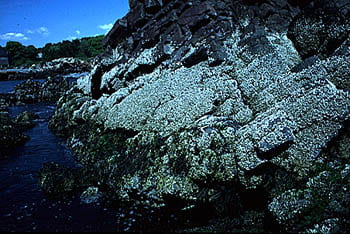
Rocks Covered by Barnacle, Semibalanus balanoides. Nahant, Massachusetts
These rocks are covered completely by a population of the barnacle Semibalanus balanoides. Adults are hermaphroditic but planktotrophic larvae disperse in the plankton for several weeks. As a consequence, it is a necessary condition that the dense populations on these rocks are derived from a dense larval settlement. In fact, newly settled S. balanoides arrive in densities far greater than shown here. As they grow, barnacles undercut and smother each other, resulting in high mortality.
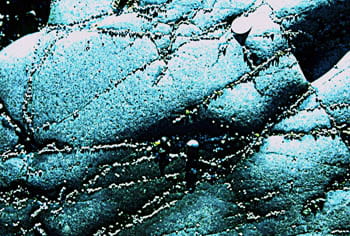
Barnacle Recruitment into Cracks Photo by Jeffrey Levinton
We see here a rocky shore at Nahant, Massachusetts, where barnacles in a high intertidal site are found only in cracks. Barnacle larvae are known to select cracks over smooth rocks, but it is by no means clear that this is the only explanation for the pattern here. It is possible for example, that barnacles settled previously on all surfaces, but that the moisture in the narrow cracks allowed some barnacles to survive hot and sunny days. Predators such as the drilling snail Nucella lapillus are abundant on these rocks and may have swept by, consuming all barnacles but the few that were in the cracks.


Recruitment to Different Nearby Boulders, Pacific Northwest
These two boulders are located in False Bay, San Juan Island, Washington. They are only about 10 m apart and the boulder sides you see have the same orientation facing away from the shore, yet they have completely different cover (barnacles at right, seaweed at left). Such differences are also found on continuous rocky shores, and it is often not clear why such great differences in dominance are found. Can you suggest some hypotheses to explain the difference?

Anthopleura elegantissima
This anemone is very common on rocky shores of the west coast of North America. Individuals are rarely more than 2-5 cm in diameter and feed on zooplankton and smaller benthic crustacea. While planktonic larvae settle on the rocks, most anemones do not originate from the plankton. Rather, a single settled individual grows and divides asexually. This process is repeated until a clone of hundreds to thousands of individuals develops.
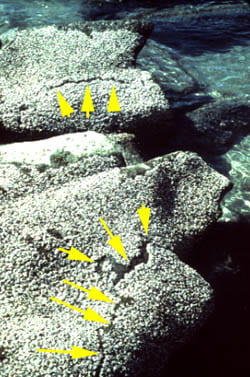
Anemone Clones and Bare Zones (arrows). Photo by Lizbeth Francis
Here is a shot of a rocky shore with large numbers of these anemones. The yellow arrows point to bare zones between clones, discovered by Lizbeth Francis. Anemones can be identified as members of a given clone by means of similar coloration and sex. The bare zones are wide enough that limpets can move freely down these inter-clonal highways.
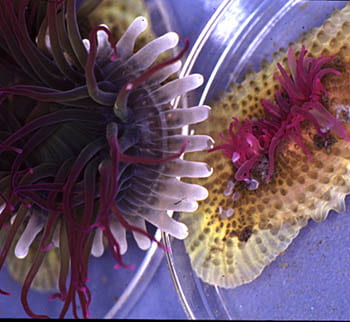
Combat Between Anemones
Like many anemones, A. elegantissima have well-developed acrorhagi (elongated white tentacle-like structures on the left anemone) that bear high concentrations of nematocysts. When two anemones from different clones (and, hence are genetically different) come into contact, one or both anemones rear back and expose the acrorhagi, which are located beneath the tentacles. In the picture at left, the left anemone is about to lower down and attack the right anemone, which is nearly contracted. The small whitish blobs on the right anemone are batteries of nematocysts that were injected in an attack a few minutes before. In the lab, the dominant anemone can kill the subordinate (these two anemones were separated before the worst happened), but in the field, withdrawal is more common, which explains the origin of the bare zones between clones.
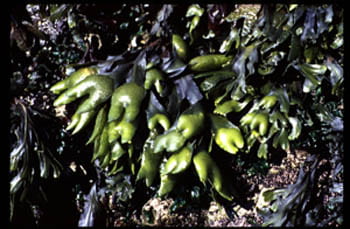
Fucus distichlus
This seaweed is common and often occupies all of the primary space of middle, upper, and even lower rocky shores of the west coast of North America. Wave action often causes the thalli to lash about, which inhibits the successful recruitment of other seaweeds and invertebrates.

Hedophyllum sessile
This brown seaweed is common on the outer coast of the Pacific northwest of the United States and dominates the lower intertidal and very shallow subtidal. Its stipe and flat blades allow it to flex and bend to minimize drag on the entire plant when waves hit the shore.
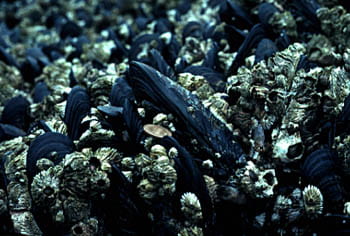
Mytilus californianus Bed (penny for scale)
On outer coast rocky shores of western North America, Mytilus californianus forms extensive mussel beds, providing that the sea star Pisaster ochraceus is not too abundant and wave shock is not strong. Scores and even hundreds of invertebrate species live on and among the mussels, which function analogously to trees in a rain forest. Mussels provide a substratum upon which to live, but they also provide a wet microclimate and even food for species that live in the interstices of the mussel bed. In this picture, you can see the barnacles attached to the mussels, but many polychaetes live among the byssal threads, and several species of the carnivorous genus Nucella prey upon barnacles and smaller mussels.

Mytilus californianus Bed
This particular bed on the outer coast of Washington State is interesting as the mussels are probably all of the same approximate age, having similar numbers of annual rings and being of a single size mode. Other mussel beds may consist of a mixture of age classes. In many cases, a mussel bed may derive from a single successful settlement that happened several years before.
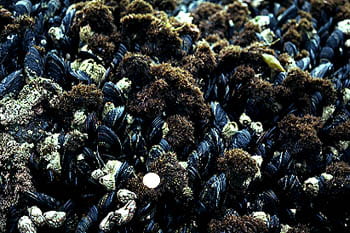
Filamentous Seaweeds and Mussel Recruitment
The seaweed Endocladia muricata is attached to mussels in this bed on Tatoosh Island on the outer coast of Washington State. As it turns out, Mytilus larvae often settle preferentially upon filamentous algae – so much so that mariculturists use ropes to encourage settlement, owing to their similar mechanical surface properties to the seaweeds. Limpets graze heavily on Endocladia, which would reduce the settlement of mussels. The sea star Pisaster ochraceus, however, preys on limpets, which indirectly enhances Endocladia growth and the settlement of mussels, which are the main prey of Pisaster.

Mytilus trossulus Clump
The mussel Mytilus trossulus * is found abundantly in protected bays of the Pacific northwestern United States, but it is also found on exposed coasts. It occurs usually as a thin band in the high intertidal, above the Mytilus californianus bed. It also colonizes in winter into patches within the californianus bed that have been opened up by storms. Robin Harger found that the greater mobility of Mytilus edulis (a very similar species to M. trossulus) resulted in its climbing on top of the more sluggish Mytilus californianus, which might result in its being swept out to sea. The clump at left, on an outer coast site in Washington State, is perched on top of a M. californianus bed and will likely be swept away in this wave-exposed habitat. Mytilus trossulus has far more slender byssal threads than M. californianus of the same size.
*Mytilus trossulus is the dominant protected water mussel of the Pacific northwest. In California, the protected shore mussel is M. galloprovincialis, which somehow invaded from the Mediterranean region. But M. trossulus is also found in very exposed shores, but in the upper intertidal, above the M. californianus.

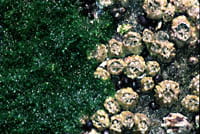
Barnacle monoculture Green seaweeds vs barnacles
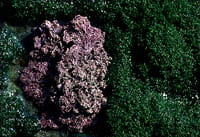

Coralline algae vs. green seaweed; Coralline algae vs. mussels
Competition Tableau
It is commonplace to see all of the available rocky space occupied by organisms, but the potential competitive interactions can be large in number, which often results in the location of monocultures of barnacles (upper left) very near other spots where two or more species are competing for the same space. These shots come from Botanical Beach on the outer Pacific Coast of southern Vancouver Island, British Columbia, Canada.

Dungeness Crab, Cancer magister. Courtesy Friday Harbor Laboratories
This crab constitutes the largest crab fishery in the eastern Pacific. It is a voracious predator, feeding on both shallow and subtidal invertebrates. Work by Sylvia Yamada shows that this and related species of Cancer are major predators on littorine gastropods on rocky shores of the San Juan Islands, Washington. How do you think such intense predation might drive the direction of the competition tableaus on the previous card?
Populations of the Dungeness crab are strongly affected by a nemertean Carcinonemertes errantia, that eats the eggs carried by the female on her pleopods.
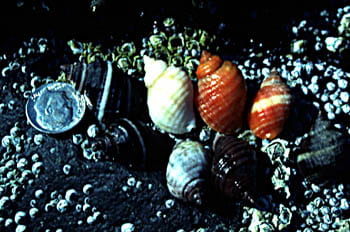
Dog Whelk: Color Variants on rocky shore at Nahant Massachusetts. photo Jeffrey Levinton
The dog whelk Nucella lapillus is a drilling gastropod that feeds mainly on barnacles on northeastern American rocky shores. Like many other mollusks, populations are polymorphic for color and banding pattern. Above (at a site in Massachusetts) you can see orange, black and white color morphs, as well as completely colored and banded individuals.
Studies on other gastropods demonstrate that these color patterns are strongly heritable and that the colors are an adaptation partially to conceal the snails from predators by matching them with the color of the background rocks (these were gathered together for this photograph). Brightly colored morphs are very rare in the natural population, likely because they are so visible to predators.
Nucella lapillus needs to be moist when the foot is outside the shell and it is restricted to the lower part of a rocky shore, where the snails can be submerged and wet for a large part of the day. They often retreat to the lower intertidal or to wet cracks in the rocks at the time of low tide, and move upwards to find prey when the tide rises. Owing to this restriction, predation by dog whelks is concentrated on the lower part of the shore.
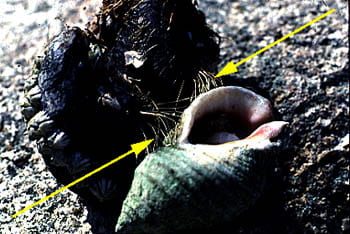
Mussel Defense Against Dog-Whelk Predator. Photo by Peter Petraitis
Yellow arrows point to byssal threads attached to the dog whelk (l. right)
The dog whelk Nucella lapillus also feeds on the mussel Mytilus edulis on rocky shores of New England. When it mounts a mussel it commences to drill a hole in the shell. Peter Petraitis has found that the mussels can fight back, however, and respond by attaching byssal threads to the snail and ensnare it, which traps them and exposes them to crab predation.
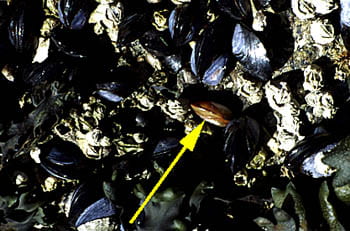
Brown Morph of the Mussel Mytilus trossulus
Mussels commonly have a blue shell color, but brown-colored morphs are also found. Here is a brown morph of Mytilus trossulus, on a boulder in False Bay, San Juan Island, Washington. On east coast populations of Mytilus edulis, the frequency of brown morphs increases southward. Studies by Jeffry Mitton and colleagues demonstrated that the lighter brown morph reflects sunlight, gains less heat, and therefore is better adapted for low-latitude exposure to the sun than the common blue morph. The genetic control for the brown morph was demonstrated by David Innes; the color is controlled by a one locus, two-allele system (brown is dominant).

Sea Star Pisaster ochraceus
This asteroid starfish occurs on rocky shores from Baja California to Alaska and was used by Robert Paine as the prime example of a keystone species. It consumes a wide variety of prey and its consumption of mussels often allows the coexistence of competing sessile rocky shore species. The right-hand individual is humped up, which is a sure sign that it is consuming prey.


Prey of Pisaster ochraceus Photographs by Jeffrey Levinton

Pisaster ochraceus on mussels, Bamfield British Columbia Photograph by Jeffrey Levinton
Records of prey consumption can be easily developed by merely turning over many starfish. The lefthand photo shows P. ochraceus consuming the mussel Mytilus californianus while at right we see a seastar consuming the barnacle Balanus cariosus.
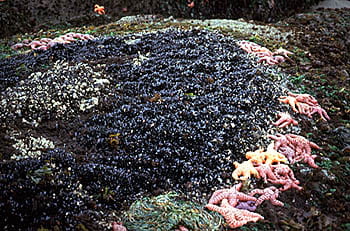
Seastars Clumped at Edge of Mussel Bed. Photograph by Thomas H. Suchanek
This is a mussel bed on a relatively flat rocky bench near Shi Shi beach on the Olympic Peninsula of Washington. Note the large numbers of Pisaster ochraceus at the lower part of the bed. These starfish have a limited time for feeding at the time of high tide and tend to feed on the lower part of the mussel bed, which is here dominated by Mytilus californianus . Carlos Robles has demonstrated that P. ochraceus moves a great deal and that large numbers can find newly settled mussels and consume them. The sea stars disperse after the newly recruited mussels are consumed.
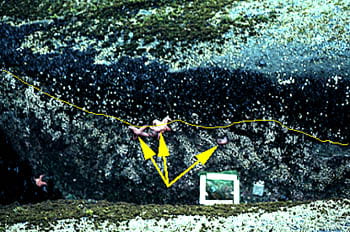
Mussel Bed, Tatoosh Island, Washington
For many years, Robert Paine and students worked on this mussel (Mytilus californianus) bed on Tatoosh Island, off of Cape Flattery, Washington. As in the previous photo, starfish are congregated (arrows) at the bottom of the bed. For many years, starfish were removed from below the bed. As a result, the lower extent of the bed moved downward approximately one meter over a decade.
Sea Star Wasting Disease. Sea stars have potent impacts on rocky shore communities as top predators. But in recent years regional warming has appeared to facilitate the spread of Sea Star Wasting Disease, which has had devastating impacts on Pisaster ochraceus populations, and also on over 20 species of sea stars in intertidal and subtidal environments of the west coast of North America. The cause of the disease is not entirely clear, although it was initially believed to be a virus. Spread of this disease in the Pacific northwest appears to be coupled to widespread warming events of surface waters.

Progressive effects of Sea Star Wasting Disease on the Sea Star Pisaster ochraceus. Disintegration of the sea star body happens in just a few days. From: Eisenlord ME et al. 2016 Ochre star mortality during the 2014 wasting disease epizootic: role of population size structure and temperature. Phil.Trans. R. Soc. B 371: 20150212. http://dx.doi.org/10.1098/rstb.2015.0212
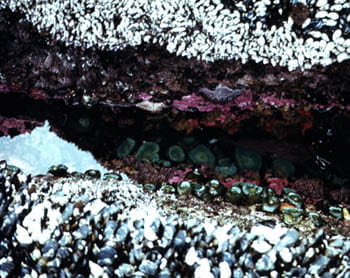
Outer Coast Tidal Pool, Tatoosh Island, Washington
This photo shows a stark contrast between the residents of a tidal pool (center) and the barnacles and mussels that are exposed at low tide. The tidal pools are nearly always submerged and creatures with less protection against desiccation can survive. The green individuals are anemones. On the top, one can see Pisaster ochraceus congregated beneath the mussel and stalked barnacle bed.
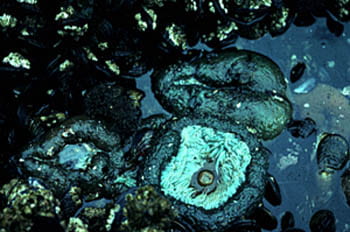
Anemones at Low Tide
While anemones are abundant in the tidal pools, they may also survive some degree of exposure to air by withdrawing the tentacles and contracting, which reduces the surface area exposed to evaporation. This is a group of Anthopleura xanthogrammica in a lower intertidal site at Tatoosh Island, Washington. They are ca. 10 cm across.

Feeding Anthopleura xanthogrammica
Anthopleura xanthogrammica are often found in tidal pools beneath mussel beds, as shown in a previous slide. When starfish pry mussels from the lower part of the bed, some are often dislodged and fall to the pool below. Indeed, the anemones probably depend upon the predation activities of the starfish to loosen and dislodge their own prey. The arrows point to two Mytilus californianus that have been fed to two anemones.
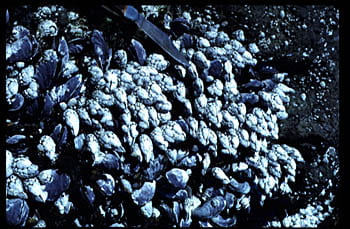
Stalked Barnacle Pollicipes polymerus
The stalked barnacle Pollicipes polymerus is common on exposed rocky coasts of the Pacific coast of North America. Its ecology is poorly understood, but it often cooccurs for many years in apparent competitive standoffs with the mussel Mytilus californianus.
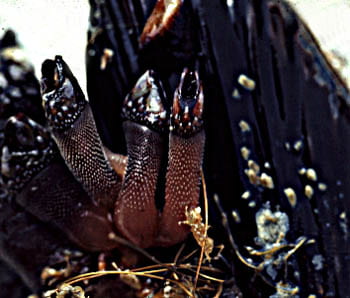
Pollicipes polymerus Closeup
These are juvenile stalked barnacles, ca. 1 cm long. Plates seem not to be calcified as yet. Unlike acorn barnacles such as Semibalanus, stalked barnacles feed nearly always by continuously protruding the cirri into the moving water, occasionally withdrawing them to scrape off the captured food.

Inducible Defense of a Barnacle. Photo by Curtis Lively
Chthamalus anisopoma is a common barnacle in the Gulf of California. It occurs in the two distinct growth forms shown here. If there are no predatory gastropods around, the barnacle grows in the erect conical form at right. But if predatory snails are in contact, then it grows bent over, which reduces access of the opening plates to the snail.
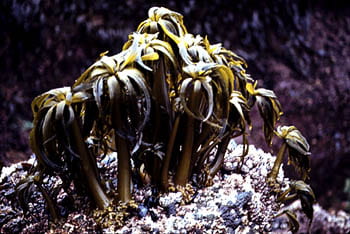
Palm Seaweed Postelsia palmaeformis
The lovely palm seaweed is typically 15-20 cm in height and is found on very exposed coasts on the west coast of North America. It apparently invades rocks that have been stripped bare of Mytilus californianus. after a storm. How initial colonists arrive is something of a mystery, but once they do, spores slide down the fronds and colonize the rocks immediately adjacent to the colonizing plant. This produces a clump such as at left.
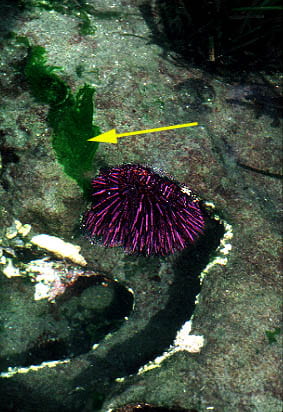
Purple Sea Urchin in Tide Pool in British Columbia Photo by Jeffrey Levinton
Yellow arrow points to drift algae caught by the Purple Sea Urchin
The urchin Strongylocentrotus purpuratus occurs commonly in crevices, which it gradually excavates by means of the powerful teeth on the Aristotle’s lantern. The rock in this pool is a relatively soft sandstone.
The urchin is therefore often restricted to one spot, so how does it gather food? Apparently a major source of food in tide pools is drift algae. Here, the elongated tube feet are catching fragments of the green seaweed Ulva sp. (yellow arrow). The tube feet transfer the seaweed ventrally to the mouth.
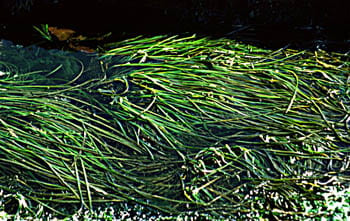
Surf Grass, Phyllospadix
This is a flowering plant, found in moderately exposed rocky shores, usually on flat and protected small areas on which sand accumulates.
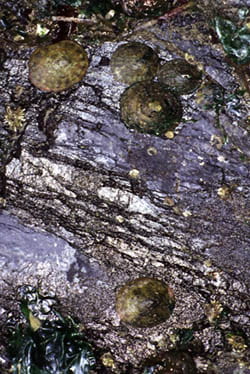
Limpets grazing
Limpets such as the eastern Pacific mid-intertidal Notoacmea scutum are important grazers on rocky shores and strongly modulate the balance of occurrence of rocky shore species. By their grazing activities they may bulldoze aside and cause early mortality of newly settled barnacles. That may be the explanation for the near absence of barnacles in this picture. If limpets are removed, thick diatom mats develop within days.
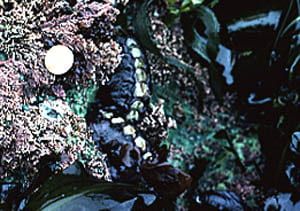
Chiton Catherina tunicata
This distinctive chiton is usually over 15 cm long and occurs commonly on the outer coasts of Alaska, British Columbia, Washington, Oregon and California. It lives near the low tide mark usually. Penny for scale.
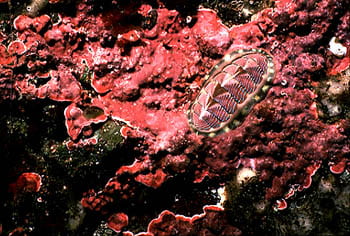
Chiton Tonicella lineata. Photo by Dan Brumbaugh
This colorful chiton is rather uncommon and is usually found on coralline algae. Its color appears to be a means of camouflage against the coralline algal background. It feeds on coralline algae. The picture is of an area 11 cm wide.
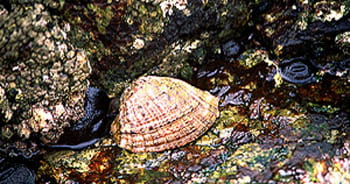
The “Loco” Concholepas concholepas. Photo by Consuelo Montero
This snail is particularly interesting, as it belongs to the family Thaiidae, but has a shell morphology much like a limpet, that differs greatly from more typical members, such as Nucella lapillus (see earlier slide). It is a wide-ranging carnivore, feeding on sea squirts, snails, and mussels. Unfortunately, it is prey to humans, as are many other animals and seaweeds on rocky shores of Chile. When protected, these shores are among the richest in the world, but they are usually denuded by human harvesting.
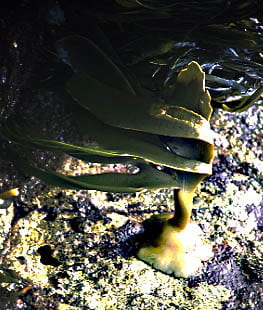
Durvillaea antarctica. Photo by Consuelo Montero
This is a common seaweed in the intertidal and shallow subtidal of Chile. In the northern hemisphere, such as in California, another species of Durvillaea often dominates the lowest part of the shore. In southern California, a species of this genus dominates kelp assemblages in more protected waters with some sedimentation.
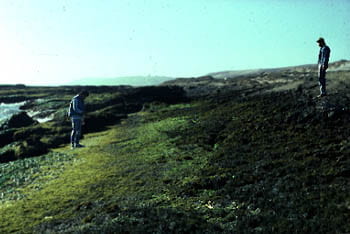
Algal Turf of Southern California. Photo by Carlos Robles
For many years, intertidal ecologists have noticed that the lower shore (left) of rocky areas in southern California is covered by an algal turf, dominated by red algae, including coralline algae. Mussels are quite sparse.
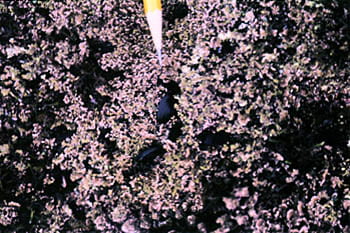
Mussels on Red Algal Turf. Photo by Carlos Robles
Here is a closeup of such a turf, with a couple of mussels (below pencil point). Why are mussels largely absent? Some had suggested that low tides combined with hot weather killed the mussels, allowing the algal turf to come to dominate. Carlos Robles and colleagues thought that there was no physiological reason why mussels should be absent in this way and started to investigate the problem on rocky shores of Santa Catalina Island.

West Coast Spiny Lobster, Panuliris interruptus. Photo by Carlos Robles
Observations by means of snorkeling, which were later combined with time-lapse photography, showed that large numbers of the lobster Panuliris interruptus came into these areas, but only at the time of high tide, especially at night in quiet waters. The picture at left shows two feeding on mussels.


Lobster Molariform Mandibles. Photos by Carlos Robles
The arrows point to the rock lobster’s robust molariform teeth, which are capable of crushing mussel shells (see inset at right).
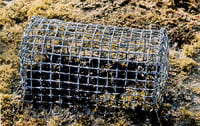
Effect of Caging on Mussel Recruitment. Photos by Carlos Robles
Robles and students performed a caging experiment, using the cages shown above. The photo shows the result. Mussel larvae recruited within the cage and grew well. Outside the cage with mussels were sparse or absent. When the cages were removed, lobsters congregated around the mussels and gobbled them up immediately.


Robert T. Paine Joseph H. Connell (photos by Jeffrey Levinton)
Much of what we have learned about rocky shore biology and community ecology derives from the pioneering field experiments done by the late great pioneers Robert Paine and Joseph Connell. Connell’s caging and removal experiments set a pattern that has resulted in rocky shores being the best understood of ecological communities, especially in understanding the relative impacts of different ecological processes such as competition and predation. Paine used these techniques to show the ecological importance of major keystone species that had disproportionate ecological impacts on community structure.
